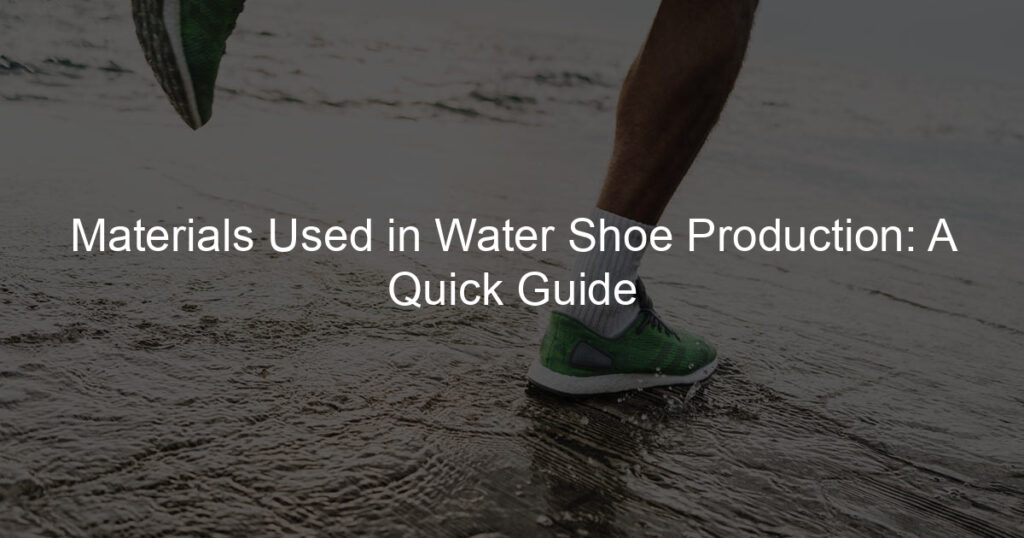Water shoes are an essential part of our outdoor adventures, providing protection, comfort, and performance in aquatic environments.
The materials used in water shoe production play a vital role in determining their durability, breathability, and overall quality.
Today, we will delve into the world of water shoe production and take a closer look at some of the materials commonly used.
Water shoes are specifically designed to maintain optimal grip, drainage, and protection while being submerged in water.
With a myriad of applications, including water sports, beach activities, and even hiking through wet terrains, it’s important to understand how the choice of materials affects the performance and longevity of these unique footwear creations.
As we explore the various materials used in water shoe production, we will also touch upon ethical and eco-friendly options.
As a consumer, being aware of the environmental impact of your footwear choices is becoming increasingly important in our ever-changing world.
Key Takeaways
- Water shoes are designed for aquatic activities, and material choice affects their performance and durability.
- Eco-friendly and ethical materials are becoming more important in water shoe production.
- Understanding the different materials used can help consumers make informed decisions when purchasing water footwear.
Water Shoes Explained
As a water shoe enthusiast, I appreciate the unique blend of comfort and functionality these shoes provide. Water shoes, also known as aqua shoes, are designed specifically for activities that involve being in and around water.
They play a crucial role in protecting our feet from sharp objects, slippery surfaces, and even hot sand.
Water shoes are typically lightweight and made from materials that dry quickly. This comes in handy during water-based activities, preventing our feet from getting weighed down or staying wet for too long.
Moreover, water shoes frequently feature a mesh upper, which allows for exceptional breathability and water drainage, making them ideal for activities such as kayaking, swimming, and paddleboarding.
The outsole of water shoes is made from durable materials, offering excellent traction and grip on various surfaces. This added safety and stability make aqua shoes a popular choice for outdoor enthusiasts and water sports lovers alike.
Additionally, these shoes have a flexible and snug fit so that they stay secure on our feet, even when submerged in water.
Apart from functionality, water shoes are available in a variety of styles, colors, and designs to suit everyone’s preferences. Some even cater to specific water-based activities, offering unique features tailored to that sport.
Water shoes make our aquatic adventures not only safer and more comfortable but also much more stylish.
Main Materials Utilised
Plastics in Water Shoe Production
When it comes to water shoe production, I often use various plastics to create comfortable and durable footwear. One such plastic is polyethylene terephthalate (PET), which is popularly used to make lightweight and flexible water shoes.
This material offers excellent water resistance, making it suitable for prolonged usage in wet environments.
Another noteworthy plastic I often employ is polyurethane (PU). Its unique property is its flexibility, which makes the shoes comfortable to wear even for extended periods.
Moreover, PU is known for its durability and resistance to abrasion, making the water shoes long-lasting. The use of plastics in water shoe production allows me to provide customers with the best possible protection while preserving the environment, as many of these materials are recyclable.
Rubber in Water Shoe Production
In addition to plastics, I frequently incorporate rubber into water shoe production for various reasons. Rubber serves as an excellent material for the soles of water shoes, providing users with a strong grip on slippery surfaces.
There are different types of rubber that I may use based on the desired characteristics of the shoe. For example, natural rubber is used for its high elasticity and flexibility.
In contrast, synthetic rubbers like styrene-butadiene rubber (SBR) and nitrile rubber (NBR) are chosen for their excellent resistance to oils and other chemicals, ensuring that the water shoes remain durable in various conditions.
Overall, by using a combination of different materials, such as plastic and rubber, I can create water shoes that are comfortable, durable, and suitable for various aquatic activities.
Ethical and Eco-Friendly Materials
Recycled Materials
I’ve discovered that many water shoe brands are now using recycled materials to create their products. For instance, some companies use recycled polyester, which is made from used plastic bottles that have been transformed into durable, high-quality fibers.
By choosing these materials, not only are we helping to reduce waste in landfills, but we’re also supporting a more sustainable production process.
Cork and Natural Rubber
Another great ethical and eco-friendly material option is cork. Cork is an amazing, renewable resource harvested from the bark of cork trees. It offers enhanced cushioning, making it an ideal material for water shoe soles.
Natural rubber is often combined with cork to create a sustainable and comfortable shoe material. Both natural rubber and cork are biodegradable, which means they won’t harm the environment when they eventually break down.
Renewable and Vegan Materials
Lastly, I want to mention the importance of renewable and vegan materials in producing ethical water shoes. Some brands are now offering shoes made from plant-based materials like algae, which not only reduces the use of non-renewable resources but also helps clean our waterways.
There are also vegan options available that do not use any animal-derived materials, ensuring that no animals were harmed during the production of the shoes.
In summary, when it comes to ethical and eco-friendly materials for water shoes, there are several great options, like recycled polyester, cork, natural rubber, and renewable plant-based materials.
By choosing water shoes made with these materials, I am not only making a positive impact on the environment but also on the welfare of animals involved in the production process.
Specific Components of Water Shoes
Water Shoe Soles
When it comes to water shoes, one of the most important components is the sole. The soles in water shoes are generally made of rubber or other synthetic materials. These materials are designed to provide excellent traction and grip on slippery surfaces such as wet rocks, boat decks, and pool areas.
Further, these soles often have drainage holes that allow water to flow through, preventing your feet from becoming waterlogged.
I’ve noticed that water shoe soles can be further divided into:
- Thin soles: These soles are lightweight and flexible, providing minimal protection and support. They are ideal for activities like beach volleyball or yoga by the water.
- Thick soles: These offer more substantial protection and support, making them perfect for activities like hiking or kayaking.
Mesh and Fabric
Another key component of water shoes is the choice of mesh and fabric materials used for the upper part. Mesh and fabric are commonly used because they are lightweight, breathable, and quick-drying.
This makes them perfect for water activities where your feet will be constantly in and out of the water. Also, they often have drainage holes or vents to facilitate the flow of water and air.
Different types of mesh and fabric materials can be used, such as:
- Nylon mesh: This is highly breathable, durable, and dries quickly. It’s ideal for water shoes intended for vigorous activities or extended periods in the water.
- Neoprene: A synthetic rubber material commonly used in wetsuits, which provides excellent insulation, keeping your feet warm even in cold water.
In summary, the specific components of water shoes, such as the soles, mesh, and fabric materials, play crucial roles in ensuring comfort, performance, and safety during water-based activities.
Using suitable materials for the outsole and upper part ensures that water shoes are designed to fulfill their intended purpose effectively. As a friendly piece of advice, always make sure to choose water shoes that best suit your needs and the specific activity you’ll be undertaking.
Manufacturing Process
When I create water shoes, the manufacturing process is a vital aspect to consider. This determines the shoe’s durability, comfort, and overall functionality.
In this section, I will outline a general overview of the manufacturing process I follow in producing water shoes.
To begin with, I select the appropriate materials for each component of the water shoe. The uppers are commonly made from mesh or neoprene, while the sole is made from rubber or a durable synthetic material.
I also choose the types of closures that suit the design, such as laces, straps, or zippers.
After gathering the necessary materials, I cut them into shapes based on the shoe’s size specification. Precision is essential at this stage, as it significantly impacts the final product’s fit and comfort.
Once the materials are cut, I start assembling the water shoe. I use solvent-based or water-based adhesives, depending on the specific materials of the uppers and soles. Solvent-based adhesives tend to offer stronger bonds, but water-based adhesives are more environmentally friendly.
I usually choose the adhesive that will provide the best balance of bonding strength and environmental impact for my water shoe design.
During the assembly process, I carefully align and attach each component. This requires precision, as misaligned parts may lead to discomfort or reduced functionality.
Once all components are in place, I use a series of stitches and seams to reinforce the connections and ensure long-lasting durability.
After assembling the water shoe, I move on to the quality control phase. I thoroughly inspect each pair to ensure that there are no defects or issues that may impact the wearer’s experience.
If I spot any problems, I address them accordingly and make necessary adjustments.
In the end, the manufacturing process of water shoes is a combination of selecting high-quality materials, precise cutting, careful assembly, and rigorous quality control.
My goal is to create a final product that offers comfort, durability, and functionality for the wearer.
Market Analysis
North America
In North America, I’ve noticed that the water shoe market is thriving with a wide range of selections for men, women, and kids. Many outdoor enthusiasts and water sports lovers like myself prefer water shoes for safety and comfort.
This has led to an ever-growing demand in this region.
From my observations, leading manufacturers are focusing on designing water shoes that cater to different consumer needs. Some prioritize support and grip, while others emphasize portability and style.
It’s interesting to see how innovation drives market variety here.
To better understand the North American market, I’ve gathered the following information:
- Target Group: Men, women, and kids with a passion for water-based activities.
- Popular Brands: Quick-dry water shoes from Speedo & Merrell.
- Key Features: Lightweight, slip-resistant, and durable materials.
Europe
As for the European market, I’ve noticed a different approach towards water shoe production. Many manufacturers here take inspiration from the region’s diverse terrains and cultural preferences.
For instance, European water shoes often incorporate natural and sustainable materials, appealing to people like me who care about environmental impacts.
Furthermore, European designs tend to be more fashionable and versatile, making them suitable for various social occasions.
Here’s a snapshot of the European water shoe market:
- Target Group: Men, women, and kids looking for stylish and eco-friendly choices.
- Popular Brands: Trendy water shoes from KEEN & Saltwater Sandals.
- Key Features: Versatile, eco-conscious, and trendy designs.
Whether you’re in North America or Europe, there’s a water shoe out there to match your style and needs. As an avid water shoe fan, I’m excited to see how the market will continue to evolve.
The Environmental Impact
As someone who is passionate about preserving our environment, I feel it’s important to address the environmental impact of materials used in water shoe production.
Producing water shoes can generate both solid and chemical waste, posing a threat to our surroundings if not managed responsibly.
A key concern is the amount of waste created during production. Many water shoe manufacturers use synthetic rubber, EVA foam, and mesh fabrics for their key components. While these materials are lightweight, durable, and quick-drying, they also contribute to landfills.
The waste generated may take hundreds of years to degrade, harming our planet’s ecosystems in the process.
Another pressing issue is ocean contamination. Some materials used in water shoe production can break down into microplastics as they wear out or if discarded irresponsibly.
These microplastics can find their way into marine life’s homes, causing harm to entire ecosystems.
To mitigate the environmental impact of water shoe production, manufacturers can take several steps. They could invest in innovative, biodegradable materials that decompose faster than conventional ones, reducing the waste burden on landfills.
Using recycled materials is another viable option – not only does this contribute to the circular economy, but it also lowers the demand for producing new, resource-intensive materials.
As a consumer, I believe it’s crucial to make environmentally conscious choices. Supporting brands that prioritize sustainability and eco-friendly practices can make a difference in protecting our planet.
By doing so, we can ensure that we continue to enjoy outdoor activities without leaving a lasting negative impact on our environment.
The Role of Suppliers
As I delve deeper into the world of water shoe production, I’ve come to appreciate the importance of suppliers in the process. They play a crucial role in providing manufacturers with the materials needed to create quality water shoes that ultimately end up on the feet of consumers.
During my research, I found that suppliers are responsible for offering a variety of materials to suit the diverse requirements of manufacturers. These materials typically include high-performance fabrics, supportive cushioning, and slip-resistant soles, all of which contribute to a comfortable and functional water shoe.
In order to maintain a good relationship, manufacturers and suppliers must frequently communicate. This ensures that the desired materials are delivered on time and according to specific quality standards.
Moreover, open communication allows suppliers to stay informed about the latest trends and preferences, enabling them to offer relevant material options to manufacturers.
To further enhance their offerings, some suppliers go the extra mile by providing value-added services. These include custom material development, product testing, and even logistical support.
These partnerships can result in exciting innovations in water shoe production, ultimately benefiting the end-user.
The role of suppliers in water shoe production is vital. With their expertise and dedication to providing quality materials and services, they help manufacturers create comfortable, functional, and stylish water shoes for people to enjoy.
Types of Water Footwear
Boots and Sandals
In my experience, water boots and sandals are among the most popular choices for various water activities, such as hiking or paddle boarding. These footwear options typically provide a good balance between lightweight materials, durability, and foot protection.
The boots are designed to keep feet dry and comfortable, while the sandals allow water to flow through, ensuring that feet remain cool even on hot days. Water sandals usually also have thicker soles to protect the feet from sharp rocks and other hazards often encountered in and around water.
Slippers and Clogs
As I’ve seen, slippers and clogs are also popular for water activities, especially for more casual events like beach days or pool parties. These types of water shoes are designed to be lightweight and easy to slip on or off, providing quick and convenient comfort.
The foam construction commonly used in both slippers and clogs makes them extremely buoyant, so you don’t have to worry about losing them while enjoying your time in the water.
- Slippers: Best for casual beach or pool use; easy to slip on and off
- Clogs: Offer more foot coverage; ideal for water parks or rockier terrain
Running and Outdoor Shoes
Finally, I’ve noticed that water-resistant running and outdoor shoes are quite popular among running enthusiasts and individuals who like to explore the great outdoors.
These shoes are designed to be lightweight, comfortable, and quick-drying, allowing runners and hikers to traverse through wet or muddy terrains without discomfort.
The durable materials used in their construction offer long-lasting performance, making them a great investment for individuals who spend their time in various outdoor environments.
| Type | Purpose | Benefits |
|---|---|---|
| Running Shoes | Running through wet areas | Lightweight, quick-drying, comfortable |
| Outdoor Shoes | Hiking, exploring | Durability, protection, versatile |
By considering the type of activity you’ll be participating in and the desired level of foot protection, you should be able to find the perfect pair of water shoes to fit your needs.
Future Trends and Innovations
As someone who is enthusiastic about water shoe production, I’m always on the lookout for innovations and trends in this industry. In the coming years, I believe we’ll see a shift in the materials used for water shoes, with a focus on sustainability and eco-friendliness.
One material that’s gaining traction is bioplastics, which are made from renewable resources such as corn, soy, and even algae. These alternatives to traditional petroleum-based plastics have the potential to reduce our dependency on fossil fuels while still providing the durability we require in water shoes.
Plus, using materials like algae would also contribute to lowering carbon emissions. This could be a game-changer in the industry.
As we strive to be more eco-conscious, energy-efficient processes in the production of materials used in water shoes are also of great importance. Incorporating renewable energy sources such as solar, wind, or hydroelectric power in manufacturing helps lower the overall carbon footprint of water shoe production.
This way, we’re not only making our shoes eco-friendly but also the process of crafting them.
Another innovative approach is the use of footwear that’s recyclable. Some companies are looking at the possibility of creating water shoes that can be broken down after use and turned into raw materials for new products.
Imagine having a pair of water shoes that, once they’ve served their purpose, can be given a new life in a different form, such as playground equipment or outdoor furniture. With this level of circular economy implementation, we could significantly cut down on waste and resource consumption.
By adopting cutting-edge, environmentally conscious technologies and materials, I believe the future of water shoe production holds promise for both users and the planet.
Together, we can work towards a more sustainable and eco-friendly future of adventure and water sports.
Frequently Asked Questions
What types of fabric are commonly used in water shoes?
When I think about water shoes, the commonly used fabrics include neoprene, polyester, and mesh. Neoprene is popular since it’s comfortable, water-resistant, and flexible, while polyester and mesh both contribute to breathability and fast drying.
How do water shoe materials provide breathability and quick drying?
The breathability and quick-drying qualities of water shoe materials come from their design. Mesh and polyester fabrics allow air to flow, carrying moisture away from your feet.
Additionally, these materials wick water away and dry quickly, making your shoes comfortable during aquatic activities.
Which materials offer the best protection in aquatic environments?
In aquatic environments, I believe rubber and neoprene offer the best protection. Rubber outsoles provide excellent grip on slippery surfaces and protect your feet from sharp objects.
Neoprene, being water-resistant and flexible, keeps your feet insulated and adapts to your movements in the water.
How do manufacturers ensure a shoe’s waterproof quality?
Manufacturers usually construct water shoes with special stitching techniques, such as seam-sealed or welded seams. This ensures that water won’t seep in through the seams easily.
They also utilize water-repellent coatings and tightly woven fabrics to prevent water penetration.
What are the key differences between men’s and women’s water shoes?
The main differences between men’s and women’s water shoes lie in their design and sizing. Men’s shoes tend to be wider and have a larger size range, while women’s shoes often have narrower designs and smaller sizes.
However, it’s important to choose a water shoe that fits comfortably regardless of gender.
How does the production process impact a shoe’s water resistance?
Quality control is critical in the manufacturing process to ensure a water-resistant shoe. Manufacturers focus on using the appropriate materials, stitching techniques, and coatings to prevent water leakage.
By monitoring each stage of the production process, they can maintain high standards of water resistance in their shoes.









